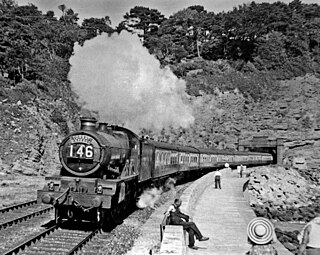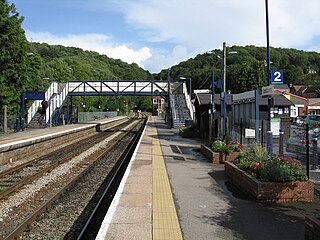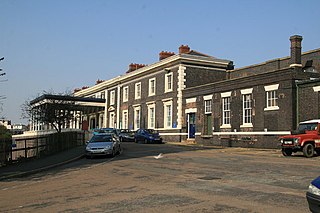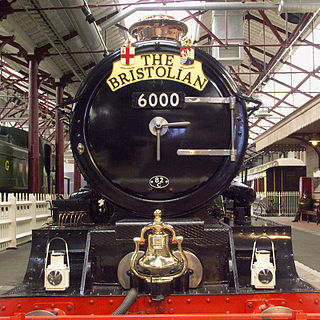
West Coast Railways (WCR) is a railway spot-hire company and charter train operator based at Carnforth MPD in Lancashire. Using buildings and other facilities previously owned by the Steamtown Carnforth visitor attraction, in June 1998 the company became the first privately owned company to be given a licence as a train operating company.

The Cotswold Line is an 86+1⁄2-mile (139.2 km) railway line between Oxford and Hereford in England.

The Torbay Express is a named passenger train operating in the United Kingdom.
London Midland and Scottish Railway (LMS) Stanier Class 5 4-6-0 5231 is a preserved British steam locomotive. In preservation, it has carried the names 3rd (Volunteer) Battalion The Worcestershire and Sherwood Foresters Regiment and The Sherwood Forester, though it never carried either of these in service.

Evesham railway station is in the town of Evesham in Worcestershire, England. It is between Honeybourne and Pershore stations on the Cotswold Line between Oxford and Hereford via Worcester and Great Malvern. It is operated by Great Western Railway. Trains to London Paddington take about 1 hour 45 minutes. It is one of the few railway stations in the United Kingdom to have shown a steady decline in use since 2004.

Hanborough railway station is a railway station in the village of Long Hanborough in Oxfordshire, England, serving the village and surrounding district. As a result of the Cotswold Line being singled the former up platform is the only one now in use for both up and down trains. It is served by Great Western Railway trains between London Paddington and Worcester Shrub Hill. It is also the nearest station to the towns of Woodstock and Witney.

Ledbury railway station is a railway station on the outskirts of the town of Ledbury on the Worcester to Hereford line in the English Midlands. It has regular services to Birmingham plus several direct trains a day to London Paddington.

The Birmingham to Worcester via Kidderminster line is a suburban railway line from Birmingham Snow Hill to Worcester via Stourbridge and Kidderminster. It is one of the Snow Hill Lines, with trains operated by West Midlands Trains and Chiltern Railways using a variety of rolling stock including Class 172 and Class 168 diesel units. It is a future aspiration of Network Rail to electrify the entire line, as well as the Chiltern Main Line to London Marylebone.

Moreton-in-Marsh railway station is a railway station serving the town of Moreton-in-Marsh in Gloucestershire, England. It is on the Cotswold Line between Kingham and Honeybourne stations. The station and all passenger trains serving it are operated by Great Western Railway.
A railtour is a special train which is run in order to allow people to experience rail travel which is not available using timetabled passenger services. The 'unusual' aspect may be the route of the train, the destination, the occasion, specific sections of railway track, the locomotive hauling the train, the rolling stock, or any combination of these. Organisers may own or hire locomotives or rolling stock, or tours may be organised by railway management or other bodies outside the railway fraternity. Perhaps the most famous railtour in England was the Fifteen Guinea Special, the last steam hauled main line train run by British Rail. Railtours are often identifiable through the use of a train headboard, often identifying the name of the specific tour or the tour operator. On TOPS, railtours are always given a 1Zxx headcode.

Colwall railway station is a railway station on the Cotswold Line serving the village of Colwall in Herefordshire, England. The station has one platform with seating. There is no ticket office; a passenger-operated Permit to Travel machine is installed, and there has been a ticket machine since 2015.

Worcester Shrub Hill railway station is one of two railway stations serving the city of Worcester in Worcestershire, England. It is managed by West Midlands Trains, operating here under the West Midlands Railway brand, and it is also served by Great Western Railway. The platform 2B waiting room of Worcester Shrub Hill is Grade II* listed and reopened in 2015 after a ten-year refurbishment project.

Worcester Foregate Street railway station, opened by the Great Western Railway in 1860 in the centre of Worcester, England, is the smaller of the two stations serving the city, but more centrally located. The other station, Worcester Shrub Hill, is to the east. A third station, Worcestershire Parkway, is located just outside the city to the south-east.

The Bristolian is a named passenger train service from London Paddington to Bristol Temple Meads. It starts at Weston-super-Mare in the London-bound direction.

Kingham railway station in Oxfordshire, England, is between the Oxfordshire village of Kingham and the Gloucestershire village of Bledington, to which it is closer. It is also the closest station to the town of Chipping Norton.

Great Malvern railway station is one of two stations serving the town of Malvern, Worcestershire, England on the Hereford to Worcester section of the Cotswold Line. It is situated downhill from the centre of Great Malvern and close to Barnards Green. The station retains most of its original Victorian station design by the architect Edmund Wallace Elmslie and is a Grade II listed building.

Malvern Link railway station serves Malvern Link in Worcestershire, England. It is one of two stations serving the town of Malvern, the other being Great Malvern station.
The Worcester and Hereford Railway started the construction of a standard gauge railway between the two cities in 1858. It had needed the financial assistance of larger concerns, chiefly the Oxford, Worcester and Wolverhampton Railway, and the Newport, Abergavenny and Hereford Railway. It opened its line progressively from 1859 to 1861, delayed by exceptionally difficult tunnelling at Colwall and Ledbury. The company was purchased by the West Midland Railway in 1860, and that company amalgamated with the Great Western Railway in 1863.

The Worcester station group is a station group of two railway stations in Worcester City Centre, England consisting of Foregate Street and Shrub Hill. The station group is printed on national rail tickets as WORCESTER STNS.

The Merchant Venturer was a named train of British Railways. It ran over eleven Summer seasons from 3 May 1951 to 9 September 1961.



















